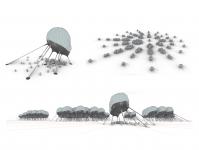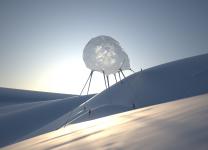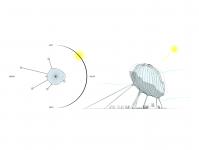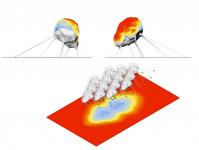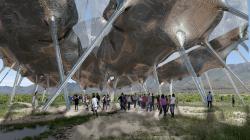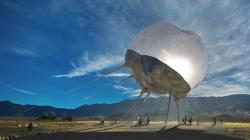EPHEMERAL STATION is a self-supporting object that is able to provide energy, water and sun protection to its users in any remote location where it is located. The idea is that the prototype is not only a communal resources collector, but also a sculptural and iconic element that will work as a gathering point for people from the area and users in general.
It is to be an innovative but harmonic shelter that will contain and create numerous activities around. These activities will be able to be supplied by the collection of its own energy but generating a minimal environmental impact on the site.
Concept
The object was the result of the two different sources of inspiration. The first one is related to the social intention, which is the banyan tree. The second one is related its function, this one the hot air balloons. Banyan trees are considered as iconic meeting points to gather communities with different purposes such as the following:
- Share protection for climatic extreme conditions.
- Communal meetings. Shared environment to gather, and exchange elements, knowledge and take decisions.
Hot balloons, on the other hand, symbolises contained energy that is able to generate more energy. In the balloon case, it becomes a movement. In the Ephemeral Station instead, this energy could become uncountable things and activities.
Sculptural object
The object won’t generate any impact in nature and the environment, but it is to create a strong impact on its users. From a long distance, it will represent an iconic sculptural object in space. From a shorter distance instead, it will create a very special feel to its close environment. The object is not static. As part of the environment, it will be moving and transforming as a consequence of the natural conditions to which it is exposed. This will modify the way in which people perceive it. The superior “cloud” of the object, will have some movement. It will expand and contract as its internal temperature changes. This movement will give the idea the object is alive and constantly breathing. Just like a living organism that produces and consumes energy.
Scale and size
Ephemeral station can be perceived as a unit, but its proportion and configuration can grow depending on the application, use and requirements. In other words, It can work by itself or be part of a major configuration.
Its scale is also variable. When the object it’s bigger, more energy and water can be collected. In this way, bigger events could be powered.
Ephemeral Station will be an innovative shelter that will give place to a huge variety of uses and functions providing everything they need to function and operate. Some examples of uses are the following:
Workshops, Talks, Campout, Theatrical Performance, Musical Events, Market Exchanges of food or goods, Temporarily settlements, Sports centres, eating areas in bigger events and any activity that requires shelter.
Some uses may require incorporating some internal partitions. This is a possibility that has also been studied together with the possibilities that different arrangements and layouts generate.
These internal partitions may allow partial internal divisions, dividing public from private areas, they can work as sun and wind protection, they can contain sound and acoustic or simply subdivide the space into smaller parcels for different users.
2020
0000
Application| Ephemeral Camp:
- Ephemeral Station in the Centre of the composition as an Iconic Civic meets the point.
- Radial Grow.
- Field of Diverse clusters and sizes of the unit according to the need.
Materiality and Constructability
Materiality
The prototype is to be constructed with completely recycled materials.
- Polycarbonate
- Aluminium
- Panels 1m x 2m
- Cotton fabric
- Steel
- Affordable and recycle Materials
Working with recyclable materials will bring about a series of advantages such as the ones listed below:
- Reducing material and waste disposal costs.
- Increasing your competitive advantage.
- Reducing your CO2 emissions.
- Complementing other aspects of eco-design
- Responding to and pre-empting changes in public policy, such as increases in Landfill Tax
Life Expand per item
- Polycarbonate exposed to the sun may be used for around 10 years
- Cotton fabric will be loaded with salts when distilling. It will be to be replaced every 2 to 3 years
- The photovoltaic panels have a written guarantee of 30 years.
- Aluminium elements and Steel Structure, will last between 20 and 30 years.
Construction
Elements of the unit:
- Primary Steel Frame Structure seating on steel plates with stake.
- A series of photovoltaic panels seating on top of the primary structure.
- Cotton fabric below the panels.
- Recycled polycarbonate balloon with an aluminium underbelly ceiling.
Offsite Construction
- Sequence of production
- Production of all elements off site into the factories.
- Preassemble.
- Transport to the part into the site
- Assemble the parts on site within minimal impact.
Speed
- Less time on-site due to fast installation
- More reliable site deliveries
- Less dependency on good weather
Quality
- Improved quality due to factory-controlled QC systems
- Less re-work on-site – factories are typically 70%-80% efficient compared to efficiencies as low as 30% for some construction projects
- Reduced need for on-site skilled workforce
Safety
- Fewer overall site deliveries
- Less time spent on-site and working at heights
Cost
- Early return on capital
- Significant cash flow advantages over traditional build
- Typically lightweight solutions offering savings to the foundation and structural design
- Cost certainty
Environment
- CO2 reduction due to fewer site deliveries
- Sustainable and can be relocated
- Less waste to landfill
Cost Estimate
- Balloon system to distilled water 250 Dollars / m2 x 300 =75000 Dollars. This is aluminium and polycarbonate.
- The primary steel structure 35000 dollars given a total of 100000 dollars.
- Photovoltaic system for the 300 m2: 250000 dollars between system and batteries to produce 263 kWh / day. The amount of photovoltaic could be reduced depending on the required consumption.
- Size 1 balloon will be a total of 350000 dollars
Sustainability and Environmental Design
The concept for the module is inspired by ‘a village tree’. This community tree offers the people perfect weather-protected canopy and at the same time, exchanges resources with the ground to become a self-supporting ecosystem.
The module is made of key components: a base support structure and a changing outer skin on top. The skin or the bubble on the top expands or contracts as a direct function of what it needs to do, how much energy it needs to capture, how much water it needs to filtrate, how much shade it needs to provide to the people below, etc.
Climate
Gerlach is one of the coolest places in Nevada. It experiences cool comfortable temperatures for 4 months of the year, from June to September, with an average high between 70 - 85oF. December has the coldest nighttime temperatures with an average of 17.8°F. This is colder than most places in Nevada.
In Gerlach, there are only 13.2 days annually when the high temperature is over 90oF while there are 193.3 days when the night time low temperature falls below freezing.
An annual snowfall of 79.4 inches means that it is one of the snowiest places in Nevada.
There are 275 sunny days and only 72 overcast days in the year. Therefore solar radiation is very high and it is an ideal location for harnessing solar energy (through solar PV or solar thermal).
Module and the Outer Skin
Solar Energy Harvester
The module is oriented towards the South and perpendicular to the Equinox’s solar position, placing it inclined to the ground plane. The solar position shifts 23.5o either way for summer (towards zenith) and winter (toward the horizon). This position ensures maximum annual solar gains to the outer shell.
90% of the incident solar radiation passes through the shell (made of recycling polycarbonate) to reach the inclined photovoltaic surfaces, almost perpendicular to the direction of solar rays. This ensures maximum energy production from the solar panels.
Elevated temperatures within the skin could cause solar PV panels to overheat. But a carefully designed evaporative cooling system that double up to provides water filtration, ensures maximum efficiency throughout the year.
Water Circuit
To avoid overheating of solar PV, an underlying fabric is introduced that remains wet as it draws water from a small water puddle within the shell.
The heated internal air in the module results in evaporation (from underneath the solar panels), thereby both cooling the panels and resulting in water droplets collecting on the module’s top inner skin. These droplets find their way to collection gutters and become a source of pure drinkable water. It is a similar process followed by small boats at sea to create fresh potable water from seawater.
The legs of the module work as capillary tubes to draw underground or surface water as it maintains the puddle in the module, sometimes with our without assistance from a pump.
The extracted water is considered potable as it has been heated and pasteurized (when it exceeds 66°C). This distilled water is used for drinking and could also be diverted to summer evaporative cooling installations (like micro-sprinklers, etc.).
An estimate on drinking water production
0.8 gal / m2.day
The distilled water would require mixing with freshwater to achieve the required levels of saline content. Depending on the level of salts in the original water, it is currently estimated that this mix could be 50% distilled water and 50% of the fresh puddle water.
Project by OF. Studio
Consultancy on environmental design: studio 4215
Consultancy Solar Energy Systems: Engineer Alfredo Esteves Miramont
This proposal was submitted for the LAGI 2020 Fly Ranch design challenge.



